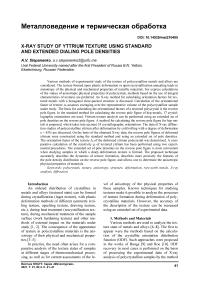X-ray study of yttrium texture using standard and extended dialing pole densities
Автор: Stepanenko A.V.
Журнал: Вестник Южно-Уральского государственного университета. Серия: Металлургия @vestnik-susu-metallurgy
Рубрика: Металловедение и термическая обработка
Статья в выпуске: 4 т.21, 2021 года.
Бесплатный доступ
Various methods of experimental study of the texture of polycrystalline metals and alloys are considered. The texture formed upon plastic deformation or upon recrystallization annealing leads to anisotropy of the physical and mechanical properties of metallic materials. For express calculations of the values of anisotropic physical properties of polycrystals, methods based on the use of integral characteristics of textures are preferred. An X-ray method for calculating orientation factors for textured metals with a hexagonal close-packed structure is discussed. Calculation of the orientational factor of texture Δi assumes averaging over the representative volume of the polycrystalline sample under study. The basis for calculating the orientational factors of a textured polycrystal is the reverse pole figure. In the standard method for calculating the reverse pole figure of hcp metals, 17 crystallographic orientations are used. Yttrium texture analysis can be performed using an extended set of pole densities on the reverse pole figure. A method for calculating the reverse pole figure for hcp metals is proposed, which takes into account 24 crystallographic orientations. The data of X-ray diffraction studies of polycrystalline yttrium after deformation by cold rolling with a degree of deformation = 45% are discussed. On the basis of the obtained X-ray data, the reverse pole figures of deformed yttrium were constructed using the standard method and using an extended set of pole densities. The orientation factor of the texture Δi of the deformed yttrium polycrystal was determined. A comparative calculation of the resistivity ρi of textured yttrium has been performed using two experimental procedures. The extended set of pole densities on the reverse pole figure is most convenient when studying samples in which a sharp deformation texture is formed. The proposed technique accurately describes the dynamics of texture formation, describes more precisely the features of the pole density distribution on the reverse pole figure, and allows one to determine the anisotropic physical properties of materials.
Polycrystals, texture, anisotropy, structure, deformation, rare-earth metals, x-ray analysis, diffraction
Короткий адрес: https://sciup.org/147236542
IDR: 147236542 | УДК: 539.261 | DOI: 10.14529/met210405
Список литературы X-ray study of yttrium texture using standard and extended dialing pole densities
- Kocks, U.F. Texture and Anisotropy. Preferred Orientations in Polycrystals and Their Effect on Material Properties / U.F. Kocks, C.N. Tomé, H.-R. Wenk. – Cambridge University Press, 2000. – 676 p.
- Золоторевский, Н.Ю. Фрагментация и текстурообразование при деформации металлических материалов / Н.Ю. Золоторевский, В.В. Рыбин. – СПб.: Изд-во Политехн. ун-та, 2014. – 208 с.
- Адамеску, Р.А. Анизотропия физических свойств металлов / Р.А. Адамеску, П.В. Гельд, Е.А. Митюшов. – М.: Металлургия, 1985. – 136 c.
- Митюшов, Е.А. Обобщенная проводимость и упругость макрооднородных гетерогенных материалов / Е.А. Митюшов, П.В. Гельд, Р.А. Адамеску. − М.: Металлургия, 1992. − 145 с.
- Hielscher, R. Material Behavior: Texture and Anisotropy / R. Hielscher, D. Mainprice, H. Schaeben // Handbook of Geomathematics / W. Freeden, M.Z. Nashed, T. Sonar (eds). – Springer, Berlin, Heidelberg, 2010. – P. 973–1003. DOI: 10.1007/978-3-642-01546-5_33
- Теория образования текстур в металлах и сплавах / Я.Д. Вишняков, А.А. Бабарэко, С.А. Владимиров, И.В. Эгиз. – М.: Наука, 1979. – 344 с.
- Методы исследования текстур в материалах / М.Л. Лобанов, А.С. Юровских, Н.И. Кардонина, Г.М. Русаков. – Екатеринбург: Изд-во Урал. ун-та, 2014. – 115 с.
- Ivanova, Т.М. The Modified Component Method for Calculation of Orientation Distribution Function from Pole Figures / Т.М. Ivanova, T.I. Savyolova, М.V. Sypchenko // Inverse Problems in Science and Engineering. – 2010. – Vol. 18. – P. 163–171.
- Bunge, H.J. Zur Darstelung algemeiner Texturen / H.J. Bunge // Z. Metallkunde. – 1965. – Bd. 56. – S. 872–874.
- Roe, R.J. Description of Crystallite Orientation in Polycrystalline Materials / R.J. Roe // Journ. Appl. Phys. – 1965. – Vol. 36, no. 6. – P. 2024–2031.
- Горелик, С.С. Рентгенографический и электронно-оптический анализ / С.С. Горелик, Ю.А. Скаков, Л.H. Расторгуев. – М.: МИСИС, 2002. – 306 с.
- Степаненко, А.В. Исследование анизотропии свойств поликристалла на основе текстурных данных / А.В. Степаненко // Заводская лаборатория. – 2019. – Т. 85, № 9. – С. 46–51.
- Бородкина, М.М. Рентгенографический анализ текстуры металлов и сплавов / М.М. Бородкина, Э.Н. Спектор. – М.: Металлургия. 1981. – 272 с.
- Берестова, С.А. Аналитический метод построения области возможного изменения текстурных параметров / С.А. Берестова, Н.Е. Мисюра, Е.А. Митюшов // Вестник ПНИПУ. Механика. – 2015. – № 1 – С. 31–42. DOI: 10.15593/perm.mech/2015.1.03
- Зиновьев, В.Е. Теплофизические свойства металлов при высоких температурах: справ. / В.Е. Зиновьев. – М.: Металлургия, 1989. – 384 с.
- Adamesku, R.A. Texture and Deformation Mechanism in Yttrium / R.A. Adamesku, S.V. Grebenkin, A.V. Stepanenko // The Physics of Metals and Metallography. – 1992. – Vol.74, no. 5. – P. 535–537.
- Степаненко, А.В. Текстурообразование при осадке и рекристаллизационном отжиге гадолиния / А.В. Степаненко // Успехи современной науки и образования. – 2016. – Т. 3, № 6. – С. 85–88.


